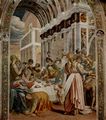Campi, Antonio
| Beruf: | Maler, Bildhauer, Illustrator |
| Geburtsort: | Cremona |
| Sterbedatum: | um 1591 |
| Wirkungszeitraum: | 2. Hälfte 16. Jh. |
| Wirkungsort: | Mailand, Piacenza, Mantua, Cremona |
Gemälde (1){{piclens text="Diashow" feedurl="/Kunstwerke/R/Campi,+Antonio/1.rss"}}
Grafiken (33){{piclens text="Diashow" feedurl="/Kunstwerke/R/Campi,+Antonio/3.rss"}}
Übersicht der vorhandenen Gemälde
- Abendmahl im Hause des Pharisäers, 1577, Cremona, San Sigismondo
Übersicht der vorhandenen Grafiken
- Illustration für Campis »Cremona fedelissima« [1], 1582–1584, Washington (D.C.), Library of Congress
- Illustration für Campis »Cremona fedelissima« [2], 1582–1584, Washington (D.C.), Library of Congress
- Illustration für Campis »Cremona fedelissima« [3], 1582–1584, Washington (D.C.), Library of Congress
- Illustration für Campis »Cremona fedelissima« [4], 1582–1584, Washington (D.C.), Library of Congress
- Illustration für Campis »Cremona fedelissima« [5], 1582–1584, Washington (D.C.), Library of Congress
- Illustration für Campis »Cremona fedelissima« [6], 1582–1584, Washington (D.C.), Library of Congress
- Illustration für Campis »Cremona fedelissima« [7], 1582–1584, Washington (D.C.), Library of Congress
- Illustration für Campis »Cremona fedelissima« [8], 1582–1584, Washington (D.C.), Library of Congress
- Illustration für Campis »Cremona fedelissima« [9], 1582–1584, Washington (D.C.), Library of Congress
- Illustration für Campis »Cremona fedelissima« [10], 1582–1584, Washington (D.C.), Library of Congress
- Illustration für Campis »Cremona fedelissima« [11], 1582–1584, Washington (D.C.), Library of Congress
- Illustration für Campis »Cremona fedelissima« [12], 1582–1584, Washington (D.C.), Library of Congress
- Illustration für Campis »Cremona fedelissima« [13], 1582–1584, Washington (D.C.), Library of Congress
- Illustration für Campis »Cremona fedelissima« [14], 1582, Washington (D.C.), Library of Congress
- Illustration für Campis »Cremona fedelissima« [15], 1582–1584, Washington (D.C.), Library of Congress
- Illustration für Campis »Cremona fedelissima« [16], 1582–1584, Washington (D.C.), Library of Congress
- Illustration für Campis »Cremona fedelissima« [17], 1582–1584, Washington (D.C.), Library of Congress
- Illustration für Campis »Cremona fedelissima« [18], 1582–1584, Washington (D.C.), Library of Congress
- Illustration für Campis »Cremona fedelissima« [19], 1582–1584, Washington (D.C.), Library of Congress
- Illustration für Campis »Cremona fedelissima« [20], 1582–1584, Washington (D.C.), Library of Congress
- Illustration für Campis »Cremona fedelissima« [21], 1582–1584, Washington (D.C.), Library of Congress
- Illustration für Campis »Cremona fedelissima« [22], 1582–1584, Washington (D.C.), Library of Congress
- Illustration für Campis »Cremona fedelissima« [23], 1582–1584, Washington (D.C.), Library of Congress
- Illustration für Campis »Cremona fedelissima« [24], 1582–1584, Washington (D.C.), Library of Congress
- Illustration für Campis »Cremona fedelissima« [25], 1582–1584, Washington (D.C.), Library of Congress
- Illustration für Campis »Cremona fedelissima« [26], 1582–1584, Washington (D.C.), Library of Congress
- Illustration für Campis »Cremona fedelissima« [27], 1582–1584, Washington (D.C.), Library of Congress
- Illustration für Campis »Cremona fedelissima« [28], 1582–1584, Washington (D.C.), Library of Congress
- Illustration für Campis »Cremona fedelissima« [29], 1582–1584, Washington (D.C.), Library of Congress
- Illustration für Campis »Cremona fedelissima« [30], 1582–1584, Washington (D.C.), Library of Congress
- Illustration für Campis »Cremona fedelissima« [31], 1582–1584, Washington (D.C.), Library of Congress
- Illustration für Campis »Cremona fedelissima« [32], 1582–1584, Washington (D.C.), Library of Congress
- Illustration für Campis »Cremona fedelissima« [33], 1582–1584, Washington (D.C.), Library of Congress
Buchempfehlung
Schnitzler, Arthur
Flucht in die Finsternis
Robert ist krank und hält seinen gesunden Bruder für wahnsinnig. Die tragische Geschichte um Geisteskrankheit und Tod entstand 1917 unter dem Titel »Wahn« und trägt autobiografische Züge, die das schwierige Verhältnis Schnitzlers zu seinem Bruder Julius reflektieren. »Einer von uns beiden mußte ins Dunkel.«
74 Seiten, 3.80 Euro
Im Buch blättern
Ansehen bei Amazon
Buchempfehlung
Geschichten aus dem Biedermeier II. Sieben Erzählungen
Biedermeier - das klingt in heutigen Ohren nach langweiligem Spießertum, nach geschmacklosen rosa Teetässchen in Wohnzimmern, die aussehen wie Puppenstuben und in denen es irgendwie nach »Omma« riecht. Zu Recht. Aber nicht nur. Biedermeier ist auch die Zeit einer zarten Literatur der Flucht ins Idyll, des Rückzuges ins private Glück und der Tugenden. Die Menschen im Europa nach Napoleon hatten die Nase voll von großen neuen Ideen, das aufstrebende Bürgertum forderte und entwickelte eine eigene Kunst und Kultur für sich, die unabhängig von feudaler Großmannssucht bestehen sollte. Michael Holzinger hat für den zweiten Band sieben weitere Meistererzählungen ausgewählt.
- Annette von Droste-Hülshoff Ledwina
- Franz Grillparzer Das Kloster bei Sendomir
- Friedrich Hebbel Schnock
- Eduard Mörike Der Schatz
- Georg Weerth Leben und Taten des berühmten Ritters Schnapphahnski
- Jeremias Gotthelf Das Erdbeerimareili
- Berthold Auerbach Lucifer
432 Seiten, 19.80 Euro
Ansehen bei Amazon
- ZenoServer 4.030.014
- Nutzungsbedingungen
- Datenschutzerklärung
- Impressum



































